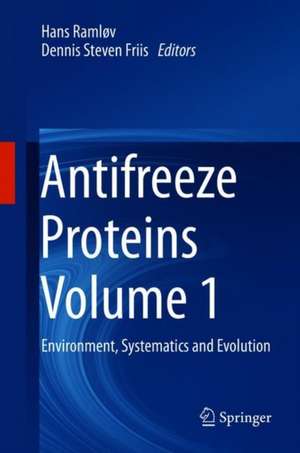Antifreeze Proteins Volume 1: Environment, Systematics and Evolution
Editat de Hans Ramløv, Dennis Steven Friisen Limba Engleză Hardback – 30 iun 2020
This first volume provides a comprehensive overview on evolutionary, environmental and systematic aspects of antifreeze proteins. It shortly explains the physical properties of ice and further intelligibly describes the biology of the antifreeze proteins in different organisms, and offers a detailed insight into their history of evolution. In addition the book discusses the status of the current knowledge and ongoing research and highlights also those parts, where further investigation needs to be done. Together with the second volume on the biochemistry and molecular biology of antifreeze proteins, this book represents a unique, comprehensive work and a must-have for students and scientists in biochemistry, evolution, physiology and physical chemistry.
| Toate formatele și edițiile | Preț | Express |
|---|---|---|
| Paperback (1) | 845.48 lei 38-44 zile | |
| Springer International Publishing – 30 iun 2021 | 845.48 lei 38-44 zile | |
| Hardback (1) | 853.48 lei 38-44 zile | |
| Springer International Publishing – 30 iun 2020 | 853.48 lei 38-44 zile |
Preț: 853.48 lei
Preț vechi: 1123.01 lei
-24% Nou
Puncte Express: 1280
Preț estimativ în valută:
163.34€ • 168.73$ • 135.94£
163.34€ • 168.73$ • 135.94£
Carte tipărită la comandă
Livrare economică 21-27 martie
Preluare comenzi: 021 569.72.76
Specificații
ISBN-13: 9783030419288
ISBN-10: 3030419282
Pagini: 313
Ilustrații: XIV, 313 p. 33 illus., 28 illus. in color.
Dimensiuni: 155 x 235 mm
Greutate: 0.73 kg
Ediția:1st ed. 2020
Editura: Springer International Publishing
Colecția Springer
Locul publicării:Cham, Switzerland
ISBN-10: 3030419282
Pagini: 313
Ilustrații: XIV, 313 p. 33 illus., 28 illus. in color.
Dimensiuni: 155 x 235 mm
Greutate: 0.73 kg
Ediția:1st ed. 2020
Editura: Springer International Publishing
Colecția Springer
Locul publicării:Cham, Switzerland
Cuprins
Introduction.- Ice and its formation.- Ice formation in living organisms.- Fish antifreeze proteins.- Insect antifreeze proteins.- Plant antifreeze proteins.- Antifreeze proteins in other species.- Molecular origins and mechanisms of fish antifreeze evolution.
Notă biografică
Dr. Hans Ramløv is professor of Comparative Animal Physiology at Roskilde University, Denmark. For the last 35 years he has investigated physiological adaptations to extreme environments in ectothermic animals with special emphasis on cold and drought. The research includes investigations on cryptobiosis in tardigrades, freeze tolerance in insects and vertebrates and since the early 1990’es various aspects of the properties of antifreeze proteins. Together with researchers from Norway and Denmark he has determined the structure of antifreeze proteins from the bark beetles Rhagium inquisitor and Rhagium mordax as well as the cloning and expression of these proteins into Escherichia coli. Via international collaboration this research has led to a suggested model for the molecular interaction of the R. mordax antifreeze protein with ice.Hans Ramløv has worked in extreme environments across the globe, from the Sahara via alpine areas in Europe and New Zealand to the Antarctic, Greenland and the north polar basin.
Dr. Dennis Steven Friis has a PhD within the field of protein chemistry, and is currently working in the pharmaceutical industry in Copenhagen. He has done both his masters and PhD on antifreeze protein research in collaboration with Hans Ramløv. The master’s thesis focused on cryopreservation of kidney cells in suspension, investigating the Rhagium mordax antifreeze proteins’ potential as a cryoprotective agent as well as freeze injuries in general. During the PhD he worked firstly on developing an efficient method to express, extract and purify recombinant antifreeze proteins using E. coli as the host organism. Hereafter, he investigated the physicochemical properties of the antifreeze protein, as well as creating various mutants of the protein and examining their effects on the hysteresis activity.After six years in collaboration with Hans Ramløv on the research on antifreeze proteins, he switched his career into the pharmaceutical industry, however, not before seizing the opportunity of being co-editor this book on the fascinating topic of antifreeze proteins.
Textul de pe ultima copertă
This first volume provides a comprehensive overview on evolutionary, environmental and systematic aspects of antifreeze proteins. It shortly explains the physical properties of ice and further intelligibly describes the biology of the antifreeze proteins in different organisms. It offers a detailed insight into their history of evolution. In addition the book discusses the status of the current knowledge and ongoing research and highlights also those parts, where further investigation needs to be done. Together with the second volume on the biochemistry and molecular biology of antifreeze proteins, this book represents a unique, comprehensive work and a must-have for students and scientists in biochemistry, evolution, physiology and physical chemistry.
Caracteristici
Informs about the evolution and systematics of antifreeze proteins
provides insight into the physical proprieties of AFPs
Presents together with Vol.2 the most comprehensive work on AFPs in general
provides insight into the physical proprieties of AFPs
Presents together with Vol.2 the most comprehensive work on AFPs in general
